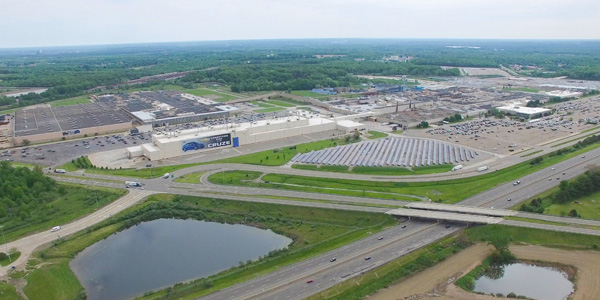
General Motors on Nov. 26 announced it will halt production at five plants in North America and eliminate 15 percent of its salaried workforce as part of a massive restructuring plan.
GM said it expects the plan to boost its annual free cash flow by $6 billion by the end of 2020.
The automaker said production will be “unallocated” at its assembly plants in Detroit; Lordstown, Ohio; and Oshawa, Ontario. GM also announced plans to cease production at its transmission plants in Warren, Michigan; and White Marsh, Maryland.
As part of the reorganization, GM said it will reduce salaried and salaried contract staff by 15 percent and reduce executive positions by 25 percent. The plan will eliminate more than 14,000 white-collar and blue-collar jobs, according to news reports.
“The actions we are taking today continue our transformation to be highly agile, resilient and profitable, while giving us the flexibility to invest in the future,” GM Chairman and CEO Mary Barra said in a news release. “We recognize the need to stay in front of changing market conditions and customer preferences to position our company for long-term success.”
During a conference call with investors, Barra added: “We are taking these actions now, while the company and the economy are strong, to stay in front of a fast-changing market and to capitalize on growth opportunities as we push to achieve a vision of a world with zero crashes, zero emissions and zero congestion.”
Consumer Shift
GM’s decision to halt production at three of its North American assembly plants reflects consumers’ ongoing shift from sedans to crossovers, SUVs and trucks. During the conference call, Barra estimated GM’s capacity utilization at its North American plants is around 70 percent.
The Lordstown assembly plant, which only produces the slow-selling Chevrolet Cruze, will cease production on March 1, 2019. The plant employs 1,435 hourly workers and 183 salaried workers, according to GM.
The Detroit-Hamtramck assembly plant will halt production of the Buick LaCrosse and Chevrolet Volt on March 1, and will cease production of the Cadillac CT6 and Chevrolet Impala on June 1. The plant employs 1,348 hourly workers and 194 salaried workers, according to GM.

The Oshawa assembly plant, which employs 2,600 hourly workers and 300 salaried workers, will shut down in the fourth quarter of 2019, according to the automaker.
GM’s transmission plant in Warren, Ohio, will shut down on Aug. 1, while its transmission plant in Baltimore will stop production on April 1, according to the automaker.
In addition to the previously announced closure of the assembly plant in Gunsan, Korea, GM announced it will cease the operations of two additional plants outside North America by the end of 2019.
“These manufacturing actions are expected to significantly increase capacity utilization,” GM said in a news release. “To further enhance business performance, GM will continue working to improve other manufacturing costs, productivity and the competitiveness of wages and benefits.”
Focus on the Future
Part of GM’s restructuring plan includes a focus on global product development. Initiatives will include increasing component sharing, using more virtual tools to cut development times and costs, and integrating vehicle and propulsion engineering teams, the automaker said.
In the next two years, the automaker said it expects to double its engineering resources dedicated to electric and autonomous vehicles.
“We will continue to maintian our strong lineup of crossovers, SUVs and trucks,” Barra added.
UAW Backlash
While investors embraced the cost-cutting plans, UAW Vice President Terry Dittes had a different take on GM’s announcement, asserting that plant closures “economically devastate the areas where these locations are operating today.”
“General Motors continues to be profitable. Very profitable. We expect them to make over $10 billion net profit this year alone,” Dittes says in a message on the UAW website. “But they forget the taxpayers, our membership, the communities, the politicians all came to them in their darkest day. There were no jobs with a bankrupt General Motors. But this is how we in America are repaid – by the closing of two big facilities. But we did not bail General Motors out so we could watch them hoard profits, shut down plants and devastate communities and take advantage of low-wage workers in Mexico or wherever they see.”

Dittes urges the public “to tell General Motors they need to build product where they sell product.”
“Because there is no job that’s safe in this country anymore when a profitable company like General Motors can quickly just shut down and make a decision in a boardroom that it’s going to end with no backlash from the American public,” Dittes says. “We need to tell them clearly that we want our products made here because this is where you sell them. And we call on GM today just as they called on all of us over a decade ago: Please save our American jobs.”
In a Nov. 27 tweet, President Trump said he is considering cutting all subsidies to the automaker.
….for electric cars. General Motors made a big China bet years ago when they built plants there (and in Mexico) – don’t think that bet is going to pay off. I am here to protect America’s Workers!
— Donald J. Trump (@realDonaldTrump) November 27, 2018






